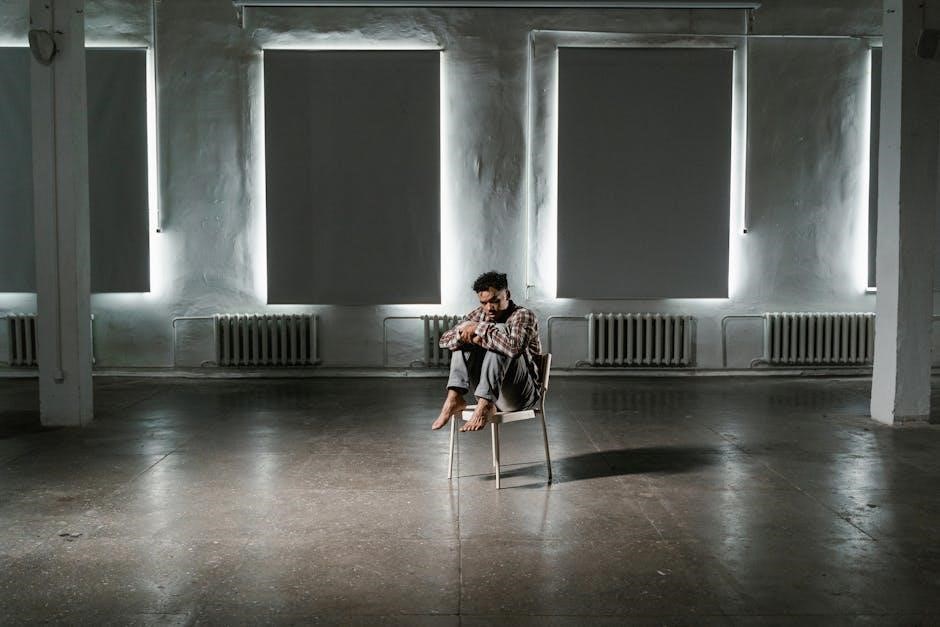Edward Albee’s Who’s Afraid of Virginia Woolf? is a gripping exploration of marriage and illusion, set in a New England college town, revealing raw truths about relationships and societal expectations.
Overview of the Play
Edward Albee’s Who’s Afraid of Virginia Woolf? is a groundbreaking drama that delves into the volatile relationship between George, a history professor, and Martha, the daughter of a college president. The play unfolds over one night, as the couple, joined by a younger couple, Nick and Honey, engages in a series of psychological games and verbal sparring. Set in a small New England college town, the play explores themes of marriage, illusion, and reality, revealing the cracks in their relationships. Albee’s masterful use of dialogue and absurdism creates a tense, emotionally charged atmosphere, making it a seminal work in modern theater.
Historical Context of the Play’s Publication
Edward Albee’s Who’s Afraid of Virginia Woolf? was first published in 1962, a time of significant social and political change in the United States. The play emerged during the rise of the civil rights movement and the Cold War, reflecting the era’s tensions and challenges to traditional norms. Its controversial themes, including harsh dialogue and critique of marriage and societal expectations, sparked debate upon its release. Despite this, the play quickly gained recognition as a landmark of American theater, aligning with the growing influence of the Theater of the Absurd movement. Its publication marked a turning point in Albee’s career and remains a pivotal work in 20th-century drama.
Edward Albee’s Background and Influence
Edward Albee, a three-time Pulitzer Prize-winning playwright, was a prominent figure in 20th-century American theater. Born in 1928, Albee was adopted into a wealthy family but rejected their lifestyle, embracing a bohemian existence. His work often critiqued societal norms, aligning with the Theater of the Absurd movement. Who’s Afraid of Virginia Woolf? solidified his reputation as a bold voice in drama. Albee’s influence extended beyond theater, impacting literature and culture. His ability to provoke thought and challenge traditional values left a lasting legacy, making him one of the most respected playwrights of his generation.

Plot Summary
Set one night after a faculty party, the play revolves around George and Martha, a middle-aged couple, and their volatile relationship. Their interaction with Nick and Honey, a young couple, escalates into a dark exploration of truth, illusion, and marital dysfunction, revealing the cracks beneath their facades.
Setting and Characters
The play is set in the home of George and Martha, a middle-aged couple, on a small New England college campus. The story unfolds after a faculty party, where the atmosphere is tense and charged with underlying conflict. George, a history professor, and Martha, the daughter of the college president, are the central characters, whose flawed and volatile relationship drives the narrative. They are joined by Nick, a young biology professor, and his wife Honey, who become entangled in George and Martha’s psychological games. The setting is intimate, with the action confined to a single location, intensifying the emotional dynamics between the characters and their interactions. The characters’ complexities and flaws are central to the play’s exploration of marriage, illusions, and human frailty.
Key Events and Turning Points
The play unfolds during a single night, with George and Martha engaging in a series of verbal sparring matches that gradually escalate into emotional warfare. A pivotal moment occurs when Martha invites Nick and Honey, a younger couple, to their home, setting the stage for a series of psychological games. George and Martha’s interactions reveal their deeply flawed relationship, marked by manipulation and bitterness. A critical turning point comes when Martha publicly humiliates George, exposing their marriage’s cracks. The arrival of Nick and Honey intensifies the tension, as they become entangled in George and Martha’s toxic dynamics. These events culminate in a shocking revelation about their fictional son, forcing all characters to confront the illusions they’ve maintained.
The Climactic Revelation and Its Impact
The play reaches its climax with the shocking revelation that George and Martha’s son, a central figure in their emotional games, is entirely fictional. This disclosure shatters the illusions they’ve maintained, forcing them to confront the raw reality of their relationship. The moment is devastating, as it strips away the layers of deceit and manipulation they’ve relied on for years. George, in particular, is deeply affected, as the truth underscores his powerlessness and Martha’s cruelty. The revelation leaves the characters emotionally exposed, highlighting the destructive nature of their bond. While it offers a glimmer of hope for change, the overall tone remains bleak, emphasizing the irreparable damage their relationship has endured.

Themes and Symbolism
Edward Albee’s Who’s Afraid of Virginia Woolf? delves into themes of illusion vs. reality, marriage, and power struggles, using symbolism to explore societal roles and human fragility.
Exploration of Marriage and Relationships

Edward Albee’s Who’s Afraid of Virginia Woolf? provides a searing examination of marriage and relationships through the dysfunctional dynamic between George and Martha. Their volatile interactions, filled with verbal sparring and emotional manipulation, reveal the fragility of their bond. The arrival of Nick and Honey, a younger couple, intensifies the tension, exposing the illusions and realities of their own relationship. The play critiques societal expectations of marriage, highlighting the emotional games and power struggles that can erode intimacy. Albee’s portrayal challenges traditional notions of love and partnership, offering a raw, unflinching look at the complexities of human relationships.
Illusion vs. Reality in the Play
Central to Who’s Afraid of Virginia Woolf? is the exploration of illusion versus reality, as characters navigate a web of deception and self-delusion. George and Martha’s relationship is built on verbal sparring and emotional games, blurring the lines between truth and fiction. Their interactions reveal how illusions sustain their marriage, masking deeper insecurities and disappointments. The play’s climax, where George and Martha confront the reality of their son’s existence, shatters these illusions, forcing them to acknowledge the fragility of their relationship. Albee masterfully uses this dynamic to critique societal expectations and the human tendency to escape reality through fantasy, ultimately exposing the raw truths beneath the facade.
Themes of Power and Control
Power and control are central themes in Who’s Afraid of Virginia Woolf?, as George and Martha engage in a relentless battle of dominance and manipulation. Their relationship is marked by verbal sparring, emotional blackmail, and psychological games, where each seeks to assert control over the other. Martha uses her status as the college president’s daughter to undermine George, while he counters with intellectual superiority and passive-aggressive humor. The arrival of Nick and Honey amplifies these dynamics, as George and Martha manipulate the younger couple to reinforce their own power struggles. This interplay of control highlights the futility of their efforts and the deeper insecurities driving their behavior, ultimately revealing the destructive nature of their relationship and societal gender roles.

Character Analysis
The play revolves around four complex characters: George, Martha, Nick, and Honey, each representing distinct facets of human relationships and societal roles, exploring themes of marriage, illusion, and power through their interactions.
George: The History Professor
George, a middle-aged history professor at a small New England college, is a central figure in the play, trapped in a volatile marriage with Martha. His intellectual prowess often clashes with Martha’s aggressive dominance, creating a dynamic of verbal sparring and emotional manipulation. Despite his sharp wit and sarcasm, George feels overshadowed by Martha’s father, the college president, and struggles with feelings of inadequacy. His passive-aggressive behavior and penchant for “games” like “Get the Guests” and “Hump the Hostess” reveal a deep-seated resentment and frustration. Throughout the play, George’s interactions with Martha and the younger couple, Nick and Honey, expose his complex character, blending humor, irony, and profound emotional depth.
Martha: The College President’s Daughter
Martha, the daughter of the college president, is a loud, boisterous, and emotionally volatile character who wields her sharp tongue and intellect to dominate those around her. Her marriage to George is marked by constant verbal sparring, as she often belittles him while simultaneously expressing a deep, albeit dysfunctional, connection. Martha’s character is a complex blend of insecurity, arrogance, and vulnerability, as she struggles with aging, unfulfilled ambitions, and the illusion of her marriage. Her manipulative nature is evident in her interactions with Nick and Honey, where she uses alcohol and provocative behavior to exert control. Martha’s larger-than-life presence and unpredictable outbursts make her a formidable and unforgettable figure in the play.
Nick and Honey: The Young Couple
Nick and Honey are a young, seemingly ideal couple invited to George and Martha’s home after a faculty party. Nick, a biology professor, is ambitious and pragmatic, while Honey, his wife, appears sweet and naive but harbors her own insecurities. Their interactions reveal a marriage built on illusions, as Honey’s innocence contrasts with Nick’s calculated demeanor. The couple becomes entangled in George and Martha’s verbal sparring, exposing their own vulnerabilities, such as Honey’s fake pregnancy and Nick’s moral compromise. Their presence serves as a mirror to the older couple’s dysfunctional relationship, highlighting themes of illusion and reality. Their dynamic evolves from politeness to raw honesty, revealing societal expectations and personal disillusionments.

Style and Dramatic Structure
Edward Albee’s play masterfully employs absurdism, creating a distorted reality. Verbal sparring and psychological tension define the dramatic structure, with three acts escalating toward a climactic revelation.
Use of Dialogue and Verbal Violence
Edward Albee’s Who’s Afraid of Virginia Woolf? is renowned for its sharp, biting dialogue, which serves as a weapon between characters. Verbal sparring between George and Martha dominates the play, revealing their toxic relationship. Their exchanges are laced with sarcasm, insults, and psychological manipulation, creating a tense atmosphere. This verbal violence not only exposes their inner turmoil but also ensnares the younger couple, Nick and Honey, in their emotional conflict. The dialogue is layered with double meanings, reflecting the characters’ emotional states and the power struggles within their marriages. Albee’s use of language heightens the dramatic tension, making the dialogue a central element of the play’s structure and thematic exploration.
Albee’s Use of Absurdism
Edward Albee incorporates elements of absurdism in Who’s Afraid of Virginia Woolf?, creating a sense of illogicality and existential despair. The play’s dialogue often defies rational progression, mirroring the chaos in the characters’ lives. George and Martha’s verbal sparring, filled with contradictions and irrational outbursts, reflects the absurdity of their relationship. The play’s non-linear narrative and ambiguous truths amplify this absurdism, leaving characters and audiences questioning reality. Albee’s use of absurdism challenges traditional storytelling, emphasizing the meaninglessness of certain human endeavors. This style underscores the emotional emptiness and the fragility of human connections, making the play a powerful exploration of existential themes.

Reception and Reviews
Who’s Afraid of Virginia Woolf? received critical acclaim for its provocative dialogue and intense character dynamics, winning numerous awards despite initial controversy over its frank content.
Initial Reception and Controversy
Edward Albee’s Who’s Afraid of Virginia Woolf? sparked intense controversy upon its 1962 premiere due to its frank portrayal of marriage, verbal violence, and existential themes. Critics were divided, with some praising its boldness and others decrying its perceived vulgarity. The play’s exploration of illusion vs. reality and its absurdist elements shocked audiences, leading to both acclaim and outrage. Despite this, it quickly became a landmark of American theater, earning critical recognition and establishing Albee as a major playwright. Its provocative nature and unflinching dialogue set it apart, making it a subject of both admiration and debate in its early years.
Critical Acclaim and Awards
Edward Albee’s Who’s Afraid of Virginia Woolf? earned widespread critical acclaim for its bold and provocative storytelling. The play won the Tony Award for Best Play in 1963, solidifying its place as a landmark of American theater. Albee’s work also received a Pulitzer Prize nomination, though he famously declined it, sparking further debate about its artistic merit. Critics praised its unflinching examination of marriage, illusion, and reality, hailing it as a masterpiece of contemporary drama. The play’s success extended beyond Broadway, influencing both theater and filmmaking. Its enduring reputation as a groundbreaking work continues to inspire new adaptations and scholarly analysis, cementing its legacy in the world of drama.
Modern-Day Revivals and Adaptations
Edward Albee’s Who’s Afraid of Virginia Woolf? continues to captivate audiences with modern revivals and adaptations. Recent productions in New York, London, and other major cities have reintroduced the play to new generations, highlighting its timeless themes. A 2024 production featuring Rosemary Cline as Martha garnered critical acclaim for its raw intensity and emotional depth. The play has also been adapted into films, further expanding its reach. Its exploration of marriage, power, and illusion resonates deeply in contemporary society, ensuring its relevance. PDF versions of the play and study guides remain popular among educators and theater enthusiasts, facilitating ongoing analysis and appreciation of Albee’s masterpiece.

Sociocultural Impact
Who’s Afraid of Virginia Woolf? has profoundly influenced American theater, challenging traditional gender roles and societal norms, while its raw portrayal of marriage and power continues to resonate deeply.
Challenging Traditional Gender Roles
Edward Albee’s Who’s Afraid of Virginia Woolf? challenges traditional gender roles through its portrayal of Martha and Honey. Martha, as the assertive and dominant wife, defies conventional feminine norms, while Honey’s passivity contrasts sharply, highlighting societal expectations. The play critiques the constraints placed on women, particularly in academia and marriage, offering a raw examination of gender dynamics. Through these characters, Albee questions the limitations imposed by traditional roles, sparking feminist discussions and redefining how gender is represented in theater. This critique remains relevant, influencing modern interpretations of gender and power in relationships.
Portrayal of American Society
Who’s Afraid of Virginia Woolf? offers a scathing critique of American society, particularly the intellectual elite and academic circles. Set in a small New England college town, the play exposes the corruption, superficiality, and hypocrisy within these circles. Through George and Martha’s volatile relationship, Albee portrays the illusion of perfection and the reality of personal and societal flaws. The play’s portrayal of academic politics, social dynamics, and the masks worn by individuals challenges the notion of a flawless American society. By revealing the cracks in these seemingly perfect lives, Albee forces audiences to confront uncomfortable truths, making the play a powerful commentary on the societal norms of its time and beyond.
Influence on Subsequent Plays and Filmmaking
Who’s Afraid of Virginia Woolf? has had a profound influence on both theater and filmmaking. Its exploration of complex relationships and verbal sparring set a new standard for dramatic dialogue. The play’s success inspired filmmakers like Mike Nichols, who adapted it into a critically acclaimed film in 1966. Albee’s use of absurdism and psychological depth influenced playwrights such as David Mamet and August Wilson. The play’s unflinching portrayal of marriage and societal norms also inspired filmmakers like Woody Allen, who explored similar themes in his work. By challenging traditional narrative structures, Who’s Afraid of Virginia Woolf? became a benchmark for experimental storytelling, reshaping the landscape of both stage and screen for decades to come. Its legacy continues to inspire new adaptations and reinterpretations.

PDF Versions and Accessibility
Who’s Afraid of Virginia Woolf? is widely available in PDF format, offering easy access for readers and scholars. Online platforms provide downloadable versions, study guides, and educational resources, making the play accessible for analysis and learning.
Availability of the Play in PDF Format
Edward Albee’s Who’s Afraid of Virginia Woolf? is widely accessible in PDF format, with numerous versions available online for download or reading. Platforms like Internet Archive and educational websites offer free access to the play, along with study guides and analysis. The 2005 Definitive Edition and other publications are also available in digital formats, ensuring readability on various devices. Fans and scholars can easily locate these resources, making the play accessible for both academic and personal exploration. The PDF versions often include annotations, introductions, and critical commentary, enhancing the reader’s understanding of Albee’s masterpiece. This accessibility has made the play a staple in literary studies and theatrical discussions worldwide.
Study Guides and Educational Resources
Various study guides and educational resources are available to enhance understanding of Who’s Afraid of Virginia Woolf?. PDF versions of analysis, character studies, and thematic explorations provide in-depth insights into Albee’s work. These resources often include summaries, discussion questions, and critical commentary, making them invaluable for students and educators. Platforms like Internet Archive and academic websites offer free access to these materials, facilitating classroom discussions and individual study. Additionally, teaching guides include lesson plans and activities to explore themes like marriage, illusion, and societal expectations. These resources not only aid comprehension but also encourage deeper analysis of the play’s complex characters and dramatic structure.
Legal and Ethical Considerations of Downloading
Downloading Who’s Afraid of Virginia Woolf? as a PDF requires attention to legal and ethical considerations. Ensure the source is authorized, as copyright infringement is a serious issue. Many versions available online may violate copyright laws, especially if shared without permission from publishers like Atheneum or Penguin Books. Respect intellectual property by using legitimate platforms or purchasing the play. Free downloads from unreliable sites risk legal consequences and support piracy. Always verify the legality of the source before accessing or sharing the PDF. Ethical considerations also involve supporting authors and publishers by obtaining the work through proper channels, ensuring fair compensation for their creative efforts.
Edward Albee’s Who’s Afraid of Virginia Woolf? remains a landmark in American theater, offering timeless insights into marriage and illusion. Its PDF availability ensures continued academic and theatrical relevance.
Legacy of “Who’s Afraid of Virginia Woolf?”

Edward Albee’s Who’s Afraid of Virginia Woolf? has left an indelible mark on American theater, celebrated for its unflinching portrayal of marriage and illusion. Its exploration of raw relationships and societal critiques earned it the Tony Award and solidified Albee’s reputation as a master playwright. The play’s influence extends beyond theater, inspiring adaptations and shaping modern storytelling. Its themes of power dynamics and marital dysfunction remain universally relevant, ensuring its continued study and performance. The availability of the play in PDF formats has further cemented its legacy, making it accessible for academic analysis and theatrical revivals, ensuring its enduring impact on drama and literature.
Continued Relevance in Modern Times
Edward Albee’s Who’s Afraid of Virginia Woolf? remains a powerful commentary on modern relationships, marriage, and societal expectations. Its exploration of illusion vs. reality continues to resonate with audiences, offering insights into human frailty and emotional complexity. The play’s themes of power dynamics, identity, and the fragility of relationships are timeless, making it a staple in contemporary theater. Modern adaptations and revivals demonstrate its enduring appeal, while its availability in PDF formats ensures accessibility for new generations of readers and performers. The play’s unflinching honesty about marriage and societal norms continues to challenge audiences, solidifying its relevance in today’s world.
